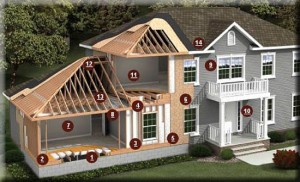3D Model with photos from your iPad
Posted by Jim Foster in 3D, BIM, New Technologies on May 9, 2012
 Autodesk announced the release of 123D Catch for the iPad. I have not yet tried the iPad version, but assume it’s mostly the same since before you chose the photographs to be sent to the cloud, and now it is sending photos you are taking from the iPad. One of the criticisms I had with it before is that you had to follow a very particular way of taking photos, which apparently I was not very good at because all my results came back looking like a kaleidoscope. However, everybody is looking for an iPad app/strategy these days and this helps. And if you get good at framing the pictures, using this on site to get basic 3D geometry, most likely for massing purposes or some initial energy analysis, well that’s very cool.
Autodesk announced the release of 123D Catch for the iPad. I have not yet tried the iPad version, but assume it’s mostly the same since before you chose the photographs to be sent to the cloud, and now it is sending photos you are taking from the iPad. One of the criticisms I had with it before is that you had to follow a very particular way of taking photos, which apparently I was not very good at because all my results came back looking like a kaleidoscope. However, everybody is looking for an iPad app/strategy these days and this helps. And if you get good at framing the pictures, using this on site to get basic 3D geometry, most likely for massing purposes or some initial energy analysis, well that’s very cool.
BIM to Grow at 17%+ Per Year Through 2020
Posted by Jim Foster in Adoption, BIM on May 9, 2012
 Recently released report from Pike Research suggests that the BIM market for software and services to grow from $1.8 Billion to $6.5 Billion, or a compounded annual growth rate of 17%+. 2D CAD Market as reported by TechNavio is to grow at 7% annually through 2015. So if I were racing… I’d chose the car that’s more than twice as fast.
Recently released report from Pike Research suggests that the BIM market for software and services to grow from $1.8 Billion to $6.5 Billion, or a compounded annual growth rate of 17%+. 2D CAD Market as reported by TechNavio is to grow at 7% annually through 2015. So if I were racing… I’d chose the car that’s more than twice as fast.
Holy Frijoles: Trimble acquires SketchUp : Game on to own Digital Buildings
Posted by Jim Foster in BIM, Built Environment, New Technologies on May 2, 2012
 As they say on Sport Center, Trimble is en fuego, they acquired Tekla earlier with a well documented, well established player, especially in the structural space who also released their own BIM product with BIMsight, and now they are acquiring Sketch Up. While all the SketchUp users are asking, ‘who the hell is Trimble?’ The Trimble folks, or AEC folks understand. Looks to me that Trimble is vertically integrating and surrounding the ‘digital’ building. Someone said to me somewhere along the line that “Leica is an engineering organization that has to sell stuff. Trimble is a sales organization that happens to sell surveying equipment” Anyway you get the gist. Makes one wonder what Autodesk will counter with now that Trimble has crashed the party. Seems like Google has decided to give up the building data market and concentrate in collecting every piece of information that exists about individuals instead. That’s too bad because it would have been interesting to see the Google Machine start to digest all that building data. However, the fact alone that they had 30 million activations in the past year has to give anyone in this space pause, then again it’s free, but free works for market penetration. And honestly isn’t the end game to get a project into your ecosphere and manage it from design to demolition, from cradle to grave and Trimble is starting to put together a pretty compelling environment. Let’s take a look shall we:
As they say on Sport Center, Trimble is en fuego, they acquired Tekla earlier with a well documented, well established player, especially in the structural space who also released their own BIM product with BIMsight, and now they are acquiring Sketch Up. While all the SketchUp users are asking, ‘who the hell is Trimble?’ The Trimble folks, or AEC folks understand. Looks to me that Trimble is vertically integrating and surrounding the ‘digital’ building. Someone said to me somewhere along the line that “Leica is an engineering organization that has to sell stuff. Trimble is a sales organization that happens to sell surveying equipment” Anyway you get the gist. Makes one wonder what Autodesk will counter with now that Trimble has crashed the party. Seems like Google has decided to give up the building data market and concentrate in collecting every piece of information that exists about individuals instead. That’s too bad because it would have been interesting to see the Google Machine start to digest all that building data. However, the fact alone that they had 30 million activations in the past year has to give anyone in this space pause, then again it’s free, but free works for market penetration. And honestly isn’t the end game to get a project into your ecosphere and manage it from design to demolition, from cradle to grave and Trimble is starting to put together a pretty compelling environment. Let’s take a look shall we:
Accubid – Cost Estimating Project Management Software : CAD based or screen take offs (acquired by Trimble August 2010)
HHK – GIS and CAD Surveying Solutions For Germany and Europe. (acquired by Trimble January 2008)
Meridian – Capital Projects and Major Renovation Management Software (acquired by Trimble October 2006)
Plancal -HVAC , Building equipment and Appliance Software (acquired by Trimble January 2012)
QuickPen – Provides Pipe and HVAC Estimating Software Solutions, CAD Detailing Solutions for HVAC and Mechanical Systems (acquired by Trimble March 2009)
Tekla – Building Information Modeling (BIM) Solutions (acquired by Trimble
Trimble Business Center – Allows you to edit, process, and adjust data from all Trimble surveying instruments from your desktop
Trimble Connected Community– Web based project management, let’s just call it the “Cloud” based management, at least they should.
So what’s all this Vertical Integration mean? Well Rockefeller or Carnegie would argue it creates efficiencies in the market place, offering you a better product for less money. However, I am more curious to how Autodesk responds. They could argue that Trimble is not a threat because they “Autodesk” are a 3D company, not just focused on AEC. It reminds me of quote from Bob Rosenberg, former CEO of Dunkin Donuts when asked about Krispy Kreme’s rise. This was at a time when Krispy Kreme was hot and expanding everywhere. CEO Rosenberg responded, “we don’t see them as a competitor.” To which you might say, are you kidding me, “DONUTS”, but he followed with “we’re a coffee company they’re a bakery.” And you know what, he was right, but we’re talking about the ownership of buildings in the digital domain, that’s big.
So we see a hardware company, Trimble, acquiring a lot of software. Would Autodesk start to acquire hardware. Although back in the day one of their product managers told me, “we don’t do hardware.” I expect to see more acquistions down the road. FARO, a publicly traded company at about $1 billion could be interesting. Where are the gaps in the portfolio? What’s next?
IFMA Releases Sustainability Guide and Carbon Footprint Measuring Guidelines for Buildings
Posted by Jim Foster in BIM, New Technologies, Smart Building, Sustainable Retrofits on May 1, 2012
 IFMA (International Facility Management Association) the leading association for facility managers released a Sustainability Guide and Measuring Guidelines for determining a buildings footprint. Buildings which account for around 40% of energy usage are perhaps the biggest consumers of fossil fuels and producers of carbon. In order to understand how buildings are consuming energy, creating carbon and determining ways to manage and reduce it IFMA published the guide and it is available for free.
IFMA (International Facility Management Association) the leading association for facility managers released a Sustainability Guide and Measuring Guidelines for determining a buildings footprint. Buildings which account for around 40% of energy usage are perhaps the biggest consumers of fossil fuels and producers of carbon. In order to understand how buildings are consuming energy, creating carbon and determining ways to manage and reduce it IFMA published the guide and it is available for free.
According to the guide and referencing a report from Groom Energy Solutions and Pure Strategies highlights the top five drivers that motivate a business to track and report carbon:
- Improved company/brand image
- Requests from top customer
- Investor pressure
- GHG regulation
- Cost savings
(Groom Energy Solutions 2010)
While surprising to me that cost savings is at #5 I think as more and more positive ROI cases are published people will realize that a path to sustainability brings more profits due to reduced operating costs. Looks to me though that the role of the FM is going to get more glamorous, and those skilled in this art should be in high demand.
UK Putting Wrapper around 5D BIM : RICS Publishes Little Black Book and NRM
Posted by Jim Foster in BIM on April 30, 2012
 The RICS (Royal Institute of Chartered Surveyors) took a step forward in putting a wrapper around the 5th D of BIM (Cost) with the publication of the New Rules of Measurement (NRM) included with the Black Book, the QS and Construction Standards.
The RICS (Royal Institute of Chartered Surveyors) took a step forward in putting a wrapper around the 5th D of BIM (Cost) with the publication of the New Rules of Measurement (NRM) included with the Black Book, the QS and Construction Standards.
the NRM suite provides a common measurement standard for cost comparison through the life cycle of cost management. The suite has been developed as a result of industry collaboration to ensure that at any point in a building’s life there will be a set of consistent rules for measuring and capturing cost data, thereby completing the cost management life cycle and supporting the procurement of construction projects from cradle to grave. A better understanding of costs during the construction process will increase certainty for business planning and support a reduction in spending on public and private sector construction projects in the long run.
You can read more on the Property Wire
Building Energy Analysis : A smorgasbord
Posted by Jim Foster in As Builts, Autodesk, BIM, Energy Analysis, Energy Modeling on April 11, 2012
 This is the case the more I learn about it, the less I know. As energy analysis picks up as a real tool in the trades, not just for sustainable retrofits, but to provide the data for financing as well and people working it from combing demographic information with utilities, to engineers, and beyond the amount of tools out there starts to become staggering…and I am sure I will be missing plenty. But half of this excercise is to get input from anyone reading this to what they are using and why. And am encouraging smack talk to why one is better than another. What follows is a completely non-exhaustive list of stuff I’ve been running into and in no particular order. For a more exhaustive list without editorial comments the DOE (Department of Energy) maintains this List.
This is the case the more I learn about it, the less I know. As energy analysis picks up as a real tool in the trades, not just for sustainable retrofits, but to provide the data for financing as well and people working it from combing demographic information with utilities, to engineers, and beyond the amount of tools out there starts to become staggering…and I am sure I will be missing plenty. But half of this excercise is to get input from anyone reading this to what they are using and why. And am encouraging smack talk to why one is better than another. What follows is a completely non-exhaustive list of stuff I’ve been running into and in no particular order. For a more exhaustive list without editorial comments the DOE (Department of Energy) maintains this List.
- EQuest – Straight out of the DOE, and while their website looks like it was designed in 1998, the claim is “Imagine a building energy simulation tool comprehensive enough to be useful to ALL design team members, yet so intuitive ANY design team member could use it” And I know people out there using it.
- BEopt – Straight out of NREL (National Renewable Energy Laboratory) – Now this seems to have some limitations and uses the DOE 2.2 engine, just as eQuest does however, one thing that popped out is the fact that you cannot call out different wall types or change sill heights to windows, which seems very limiting, yet, people are out there using it.
- EnergyPlus : ” is a whole building energy simulation program that engineers, architects, and researchers use to model energy and water use in buildings”
- The Autodesk Family
- Green Building Studio – This a web based service that allows for a variety of analysis including:
- Whole Building Energy Analysis
- Carbon Emissions : Footprint
- Weather Analysis
- Design Alternatives
- Water Usage
- Energy Star Scoring
- GBS uses gbXML and is interoperable with Revit and….yes the DOE 2.2 Engine.
- Ecotect : How this is different than GBS, I don’t know, but if you buy Ecotect you get GBS along with it..but both have similar claims.
- Vasari : More energy analysis but at the design concept stage
- Google : Sketch Up Family
- IES Plug In – Allows you to apply materials onto a Sketch Up model for import into an IES tool
- Energy Plus Open Studio Plug In – All the EnergyPlus option through your SketchUp model
- GreenSpace Modeler : Allows you to apply gbmxl textures to a sketchup model for import into a gbmxl tool for analysis like Green Building Studio
An excellent resource I found through WBDG is the a summary of Energy Analysis Tools, including DOE 2.2, BLAST, EnergyPlus, and the like. Plus there is a whole list of BLCCs (Building Lifecycle Cost) Programs.
I guess the point is just when you think BIM is going to solve everything with a push button, no matter which ecosphere you live in, be it Autodesk, Archicad, etc. there are tool sets out there, and more importantly ‘free’ tool sets out there that get a lot of play. What worksflows and tools are you using for building / energy analysis?
Open Source IFC Authoring Tool
Posted by Jim Foster in BIM, IFC on March 30, 2012
 Can this really happen? The Intellicad Consortium did it with Autocad and .dwg, so much so that Autodesk countered with RealDWG. How about a generic IFC model that can be digested by all BIM packages, or imported directly for Energy Analysis. And before anyone states that all BIM packages can import IFC, you ever try to round trip an IFC model, that is export it to IFC, from say Revit, and then import that same IFC model, does it look the same, behave the same?
Can this really happen? The Intellicad Consortium did it with Autocad and .dwg, so much so that Autodesk countered with RealDWG. How about a generic IFC model that can be digested by all BIM packages, or imported directly for Energy Analysis. And before anyone states that all BIM packages can import IFC, you ever try to round trip an IFC model, that is export it to IFC, from say Revit, and then import that same IFC model, does it look the same, behave the same?
How about a system evaluated solely on its feature set, in fact, what it can do to the model becomes more important than the modeling itself. Now that would be a nice arms race, who could offer better compatibility between programs, offer programs and add-ons, come up with a real server centric model that wraps in all the subs in a coherent and logical way. No more design model, model for constructability, model for FM. One where any updates are integrated to the model and available.
Where is the Linux of the AEC world?
Open BIM? Who really has a vested interest in the care and feeding of an open platform?
Posted by Jim Foster in Autodesk, BIM on March 14, 2012
 So straight out of Budapest….and Boston comes the PR Release of Open BIM. I am for Open BIM, I love the idea of working in a platform agnostic environment and make the building all about the data not the platform, however, when Open BIM is made up of a consortium of companies that have a vested interest in the process, such as Nemetshek, Tekla and Trimble at least the antennae are going to go up.
So straight out of Budapest….and Boston comes the PR Release of Open BIM. I am for Open BIM, I love the idea of working in a platform agnostic environment and make the building all about the data not the platform, however, when Open BIM is made up of a consortium of companies that have a vested interest in the process, such as Nemetshek, Tekla and Trimble at least the antennae are going to go up.
“Open BIM Programme is a marketing campaign initiated by GRAPHISOFT®, Tekla® and other members of buildingSMART® to urge and facilitate globally coordinated promotion of the Open BIM concept throughout the AEC industry, with aligned communication and common branding available to programme participants.” This is taken right from the buildingSMART website. Now buidlingSMART appears to be the outgrowth of the IFC initiative which was started by Autodesk in 1994, however, Autodesk now does not appear to be a part of this? Why not?
I think fighting against the hegemony of the Autodesk dreadnaught is okay but one has to a question an open standard in this space. As far as I know there is no open source BIM authoring tool, which would be super cool; so then who has a vested interest in the ‘open’ standard and supporting it? I know if I have an ancient CAD file I can still open it in AutoCAD because you have a for profit company investing in itself and it’s long tail, open standard? Not sure if it works. Would I be able to open a file that was saved in an IFC format twenty years from now? I can still open a Revit file that is 7 years old. Is this a capitalism vs. socialism equation? I would not go that far but there is a whole lot invested in software to design/manage buildings digitally so what does Open really mean in this case besides just a ‘marketing campaign initiated from Graphisoft…” As my dad always says, usually when you want to know the motivation for something, “follow the money.”
I’ve written about this before and I think in the ideal world the building, the BIM, is open and people just write apps for the model, as current apps put a nice wrapper around open data so can BIM apps. Need energy analysis, buy the app, space management, buy the app but the initial creation and file formatting lies in the BIM authoring tool, Revit, Archicad, etc. How does the centralized BIM server model work when changes are made, etc. and what file format is it kept in that will have the legacy to support it? Perhaps after the building is designed or existing building is captured in a BIM platform it can be translated into the IFC, whathave you, open platform and then becomes the defacto standard for existing buildings (EB), but during the design process? There are a lot of people with a vested interest to keep it in their ecosystem. Who will invest, support and nurture an Open BIM standard and to what end?
Start Up Poison…Hubris
Posted by Jim Foster in Entrepreneurship on March 7, 2012
This happens in all organizations but is quicker to be fatal in a start up than a bigger organization just like a Cobra biting, say a Dingo; compared to an elephant. And for those of you who might write me to say that a Dingo would not be found in the same place as a cobra, well, it’s fun to say dingo. However, I have presented at conferences where the main component was the introduction of new software; the company was Autodesk and the software was Revit. When it came time for the Autodesk Revit folk to present, they immediately threw Autocad under the bus saying Revit was the future and you were a dope if you did not adopt it. Never mind that almost the entire room was filled with Autocad users that had made large investments in software and workflows around Autocad but essentially they were calling them idiots. Instead of showing them a migration path to the new stuff, success stories, improved work flows, the presentation was feature driven and how Revit kicks ass. As a consumer of the software instead of thinking wow BIM is the future and the future is Revit. I might come out and say BIM is the future, these guys are jackweeds and now is the time to look at all my BIM options.
From a start up perspective, this is deadly. If you are trying to get people to adopt new software and create new works flows around it calling someone a dope in words, deeds or attitude is like putting five in the chamber before spinning. To illustrate here is the basic example which happened recently. The start up is getting a bit of traction, some pilots are coming on line and they take that small amount of validation as confirmation of their business plan, software, work… inevitability and the ego starts to inflate. Listen, getting any amount of validation when you are a start up is awesome, you are usually working in a closet with the sheer belief in yourself as fuel so enjoy it but generally it means you now need to double down on your work because a new round of expectations. However, I continue to see “wow we were right all along, here it comes.” So through this conversation I heard “this guy is an idiot he does not understand what we are trying to do.” Okay but this guy is the one who is managing the pilot and he was probably put in charge because he is skeptical and really needs to be ‘wowed’ if you hope to attain any more traction rather that treating him like an idiot because you and your widget is inevitable. The founding team switches gears from gathering key advisors, creating consensus, etc. to treating people like sub-contractors such as, you want to get on the bus you can take it or leave it but we need your input by tomorrow or we’re moving on.’ So now it feels like they are selling used cars,” offer is good today”, “you want the undercoating?” and the things that got them to that stage start getting dropped because now they feel like they deserve it. And work and information that use to flow to them because of their eagerness to learn starts to dry up. I have seen this happen multiple times and the next stage is, okay how about for your work and effort I will give you piece of my ego filled balloon and at this point, most of the time, it is too late. They have burned through their initial contacts, industry experts, etc. and now they believe, wrongly, that a piece of the pie will motivate/re-motivate people when in fact that equity piece if sincere should have been offered up front to engage and motivate not as a life raft from the sinking ship.
Compare this to a recent post from Andrew Chen, “Why you always think your product is shit.” Which I thought was a great post and you should make the jump but the crux of it is, if you really care about what you are creating, you will never be satisfied because it can always do more; be more. He uses a trip to and anecdotes from Pixar to make his point. How many of you who have seen a Pixar movie ever seen a technological flaw in the process? Not me, it’s always been magic. From Andrew’s post, quoting Matt Silas of Pixar about the movies, ” … when you are watching the movie, you can see all the flaws, and it isn’t until you see the faces of your friends and family that you start to forget them.” That’s what you work for, that’s what drives you, you believe your work can be transformative, you are not “The” shit, you are because you give a shit, you care, you wants things to be better. You’re an artist, you’re an entrepreneur.
Residential BIM……..there you are
Posted by Jim Foster in BIM, New Technologies on February 15, 2012
 So a recent article at Constructech, A Platform for Residential BIM, got me to digging. Mostly, it outlines how Instinct Residential Design System is gluing together a variety of systems to create and integrated model and delivery system. Yeah I said glue. We saw Autodesk’s recent acquisition of Horizontal Glue and from their site, Glue…
So a recent article at Constructech, A Platform for Residential BIM, got me to digging. Mostly, it outlines how Instinct Residential Design System is gluing together a variety of systems to create and integrated model and delivery system. Yeah I said glue. We saw Autodesk’s recent acquisition of Horizontal Glue and from their site, Glue…
- One central repository that manages models across all trades
- No interoperability and file format exchange issues
- Exchanges between BIM and Project Management Systems
- Integrated building model version control
And while the Instinct web site serves up the more generic reasons for why to use BIM, they could probably take Glue’s bullet points above and paste them in because of they have bolted together a variety of products including VisonRez, which is from AmeriCAD and runs on an Autodesk backbone, which was ADT (Architectural Desktop) now Autodesk Architecture and has the benefit of of Autocad familiarity. It also includes VIEW, hsbCAD and Intellibuild compatibility into the bundle. Changes in the model can be driven through to all stakeholders. Changing components allows wall systems to be verified, HVAC and plumbers to reroute and get the right stuff on the truck. Sounds just what you want out of a centralized model and one of the pillars of BIM.
Side Bar
When people think of BIM, they don’t necessarily think of ADT (Architectural Desktop) / AutoCAD Architecture but no one should be surpised that ADT has such a long tail. I know and liked the package and it is easy to draft in, and uses the same commands as Autocad. Also I’ve been in meetings and conferences where the BIM sales team throws the same companies CAD and/or “older” offerings under the bus. I don’t think denigrating anything is the way to sell and if this solves a problem, gets people working on the same page, reduces errors and changes, centralizes the model, well all right. BIM is a big tent and it’s a way of thinking and integrating, it is not any one software platform. Why use a crow bar to open a door when you have the key. What’s the key people? That’s key.


